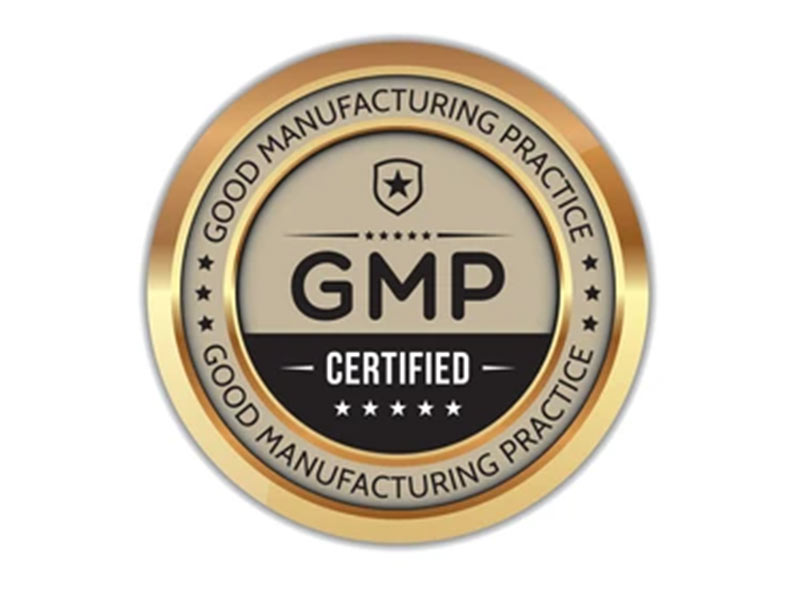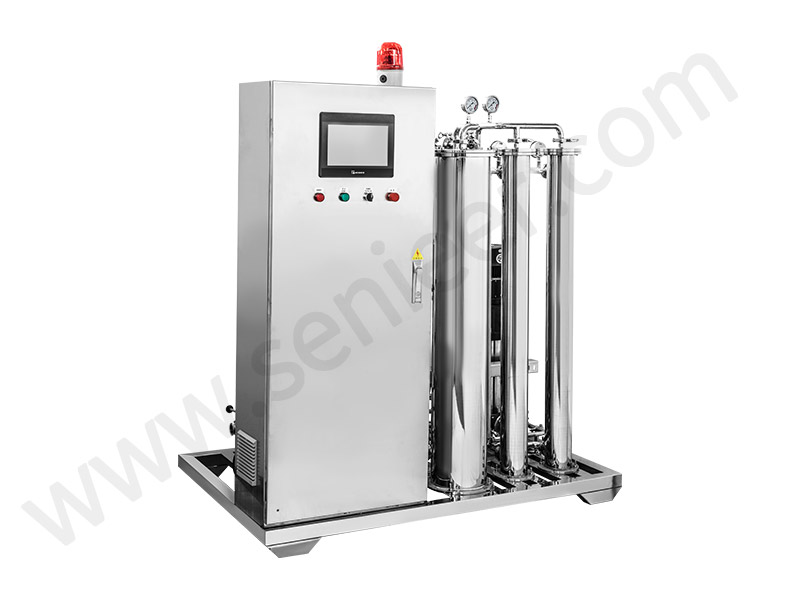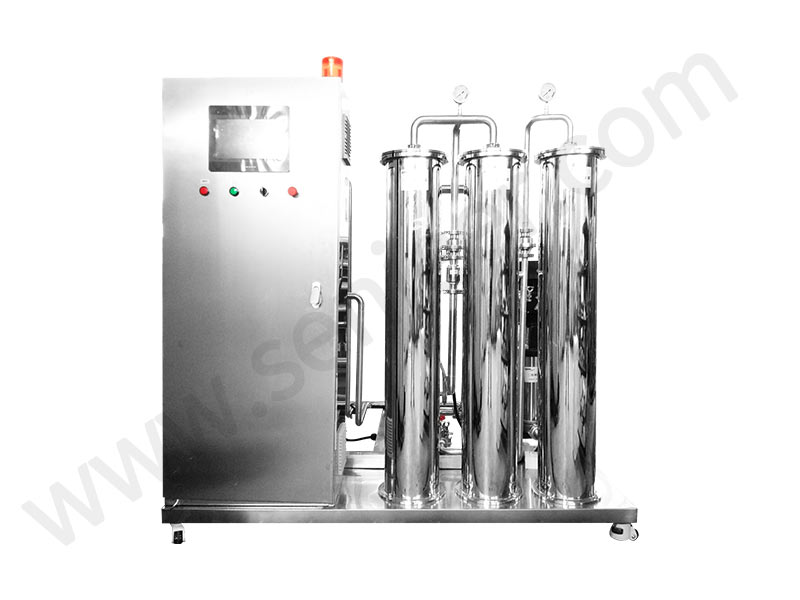1. About GMP Certification
Hospitals, food, pharmaceuticals and other safety and health-related industries, from each process must be certified by the relevant national agencies to ensure that the quality of production meets the requirements of harmless to the human body.
Taking medical purified water equipment as an example, its main use is to produce ultra-pure purified water for pharmaceutical, food, hospital and other industries, and the purified water used must be sterile, non-conductive, and pure water without any impurities, and the importance is self-evident. Therefore, the state has set up a GMP certification body to ensure that these industries meet certain indicators with purified water.

2. GMP Certification Requirements For Medical Water Equipment
(1) The structural design should be simple, reliable and easy to disassemble and assemble.
(2) In order to facilitate disassembly, replacement and cleaning of parts, the design of the actuator adopts standardized, generalized and systematic parts as much as possible.
(3) The surface of the inner and outer walls of the equipment is required to be smooth and flat, without dead angles, easy to clean and sterilize. The surface of the part should be chrome plating and other surface treatment to resist corrosion and prevent rust. Avoid paint on the outside of the device to prevent flaking.
(4) Equipment for the preparation of purified water should use low-carbon stainless steel or other materials that are verified not to pollute water quality. The equipment used to prepare purified water should be cleaned regularly and the cleaning effect verified.
(5) The materials that come into contact with water for injection must be high-quality, low-carbon stainless steel or other materials that have been verified not to pollute water quality. The equipment for preparing water for injection should be cleaned regularly and the cleaning effect should be verified.
(6) The storage cycle of purified water should not be greater than 24 hours, and its storage tank should be made of stainless steel material or other materials that have been verified to be non-toxic, corrosion-resistant, and do not exude polluting ions. Protecting its vents should be fitted with a hydrophobic sterile filter that does not shed fibers. The inner wall of the tank should be smooth, and the nozzles and welds should not have dead corners and trachoma. Sensors that display parameters such as liquid level, temperature and pressure should be used without forming stagnant water pollution. The storage tank should be cleaned, disinfected and sterilized regularly, and the cleaning and sterilization effect should be verified.
(7) Transportation of pharmaceutical water
(8) Purified water and pharmaceutical water should be transported by stainless steel pumps that are easy to disassemble and clean and disinfect. In the case of purified water and water for injection that need to be pressured with compressed air or nitrogen, the compressed air and nitrogen must be purified.
(9) Purified water should be transported by circulating pipeline. The piping design should be concise and blind tubes and dead corners should be avoided. The pipeline should be made of stainless steel pipe or other pipes that are verified to be non-toxic, corrosion-resistant and do not exude contaminating ions. The valve should use a sanitary valve without dead angles, and the flow direction of the purified water should be marked.
(10) Pipelines and pumps transporting purified water and water for injection should be regularly cleaned, disinfected and sterilized, and can only be put into use after passing the verification.
(11) The design of the pressure vessel shall be undertaken by the licensed unit and qualified personnel, and shall be handled in accordance with the relevant provisions of the national standard of the People’s Republic of China “Steel Pressure Vessel” (GB150-80) and the “Pressure Vessel Safety Technical Supervision Regulations”.
3. GMP Verification Content About Purified Water Equipment
1) The dosing system of purified water equipment has dosing systems such as precipitants, coagulants, and scale inhibitors. The main equipment is the metering box, the metering pump.
2) Activated carbon filter for purified water equipment.
3) 5μm micron filter (security filter) —
4) Reverse osmosis system (RO) Main equipment: high-pressure pump, reverse osmosis device, reverse osmosis (RO), etc. The salt removal rate of reverse osmosis membrane is 95%~99% Bacterial isolation rate >99% organic matter removal rate is 100% (relative molecular mass>300); Pyrogen removal rate >99% 95% to 99% (relative molecular mass <300) Particle removal rate >99%.
Equipment confirmation points:
① Integrity test of reverse osmosis membrane.
② Monitoring of flow, pressure, temperature, chlorine, PH, concentrated water discharge rate, TOC, and conductivity of reverse osmosis systems in purified water equipment.
③ Effects of residual chlorine, pH, water temperature, and pollution indicators on removal rates.
④ The water quality requirements for the reverse osmosis system in the purified water equipment: residual chlorine < 0.1 mg/L, water temperature 4 ~ 40 °C, PH5 ~ 8, pollution index SDI <4.
5) Purification of water equipment disinfection system, usually purified water equipment and pipeline disinfection methods are pasteurization, ultraviolet disinfection, ozone disinfection, steam disinfection, etc., the distribution system of injection water is mainly pure steam disinfection.

① pasteurizers: With a heat exchanger, steam or electric heating as a heat source, the disinfection medium is the purified water itself in the purified water system; It is also possible to heat the purified water in the tank directly (via a jacket) as a sterilizer. The water temperature should be controlled above 80 °C, and the water pump circulation should be opened to flush the water treatment equipment and pipelines for 60min.
② Ozone sterilizer
③ Sterilization in ultraviolet water: Ultraviolet light with a wavelength of 254 nm can kill bacteria in the water when it passes through the water layer. The ultraviolet sterilization device is composed of an outer cylinder, a sterilization lamp, a quartz casing and electrical facilities. The germicidal lamp is a high-intensity low-pressure mercury lamp that emits ultraviolet light with a wavelength of 253.7 nm. In order to ensure the bactericidal effect, its ultraviolet amount is required to be greater than 3000.
4. Common Problems Encountered By Purified Water Equipment For GMP Certification
In addition to the design and manufacture of purified water equipment systems to meet the 2010 pharmacopoeia or other pharmacopoeia standards, the design and manufacture of purified water equipment systems must also meet the certification requirements of GMP. Biomedical and pharmaceutical purified water equipment attaches more importance to these two points, so what are the requirements of GMP for purified water equipment systems? How should these problems be avoided? How to quickly pass the GMP certification? According to the relevant requirements of GMP certification and the experience of many GMP purified water equipment cases, a purified water equipment manufacturer summarizes some common GMP certification problems for reference:
1) The purified water equipment does not have a PID diagram installed.
2) Pure water equipment does not have a sampling point number.
3) The number of water points needs to be added to the purified water system; There is no flow direction marking in the pipeline above the purified water storage tank;
4) Purified water physical and chemical testing records: no volatiles detection and weighing without original printing records; The detection of conductivity should be added to the unit; Its entire record is too thick and operable.
5) The purified water system comes out of EDI is purified water, but the pipelines and valves, water pumps, and pressure gauges on the site are not done according to the standards of purified water, and there is a risk of pollution.
6) The purified water system did not verify that the automatic solenoid valve was acting correctly.
7) There is no drawing when installing purified water on-line conductivity monitoring.
8) Purified water without management design drawings, pipeline non-hygienic connection, no daily monitoring, pipeline design is not conducive to sampling.
9) Purified water irrigation and welding do not meet the requirements, should use one side welding two sides of the molding process, and provide purified water pipe endoscopic photos.
10) There is no sampling record in the purified water equipment system; A flow meter should be installed at the backwater of purified water.
11) The purified water system needs to conduct weekly full inspection of the total delivery, total return, storage tank, and farthest water point, and the rest of the water points are inspected every month.

12) Verification of purified water system, verification of IQ\CQ\DQ and other performance of purified water equipment system.
13) The design, installation, ozone disinfection basis, welding, verification and confirmation of purified water do not meet the requirements.
14) The drawings of the purified water equipment do not match the actual design, and each control valve should be noted on the drawings.
15) Pipes, water storage tanks, welding problems.
16) Reserve outlet, the return outlet should have a thermometer in order to control its temperature changes, and there should be a flow monitor.
17) The connection method of the purified water pipe interface should adopt a hygienic clamp connection method, and the use of silk tooth connection method should be eliminated.
18) Purified water section pipelines should be automatic welding process and professional pipe cutting tools.
19) The recirculating line installation has no slope and the lowest point is not designed to be the discharge point.
20) There are dead ends in the pipes of the purified water system, which are easy to breed microorganisms and bacteria.










